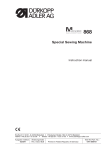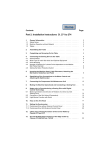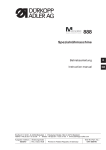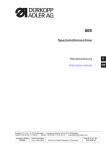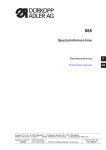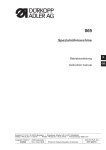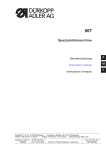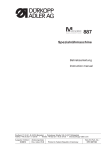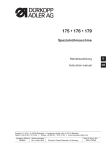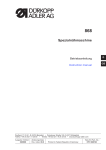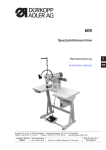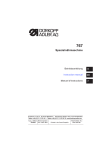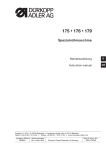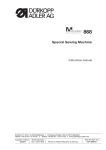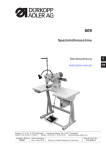Download Duerkopp Adler 838 Instruction manual
Transcript
838 Spezialnähmaschine Betriebsanleitung D Instruction manual GB Postfach 17 03 51, D-33703 Bielefeld • Potsdamer Straße 190, D-33719 Bielefeld Telefon +49 (0) 521 / 9 25-00 • Telefax +49 (0) 521 / 9 25 24 35 • www.duerkopp-adler.com Ausgabe / Edition: 10/2008 Änderungsindex Rev. index: 00.0 Printed in Federal Republic of Germany Teile-Nr./Part.-No.: 0791 838740 Alle Rechte vorbehalten. Eigentum der Dürkopp Adler AG und urheberrechtlich geschützt. Jede, auch auszugsweise Wiederverwendung dieser Inhalte ist ohne vorheriges schriftliches Einverständnis der Dürkopp Adler AG verboten. All rights reserved. Property of Dürkopp Adler AG and copyrighted. Reproduction or publication of the content in any manner, even in extracts, without prior written permission of Dürkopp Adler AG, is prohibited. Copyright © Dürkopp Adler AG - 2008 Foreword This instruction manual is intended to help the user to become familiar with the machine and take advantage of its application possibilities in accordance with the recommendations. The instruction manual contains important information on how to operate the machine securely, properly and economically. Observation of the instructions eliminates danger, reduces costs for repair and down-times, and increases the reliability and life of the machine. The instruction manual is intended to complement existing national accident prevention and environment protection regulations. The instruction manual must always be available at the machine/sewing unit. The instruction manual must be read and applied by any person that is authorized to work on the machine/sewing unit. This means: – – – Operation, including equipping, troubleshooting during the work cycle, removing of fabric waste, Service (maintenance, inspection, repair) and/or Transport. The user also has to assure that only authorized personnel work on the machine. The user is obliged to check the machine at least once per shift for apparent damages and to immediatly report any changes (including the performance in service), which impair the safety. The user company must ensure that the machine is only operated in perfect working order. Never remove or disable any safety devices. If safety devices need to be removed for equipping, repairing or maintaining, the safety devices must be remounted directly after completion of the maintenance and repair work. Unauthorized modification of the machine rules out liability of the manufacturer for damage resulting from this. Observe all safety and danger recommendations on the machine/unit! The yellow-and-black striped surfaces designate permanend danger areas, eg danger of squashing, cutting, shearing or collision. Besides the recommendations in this instruction manual also observe the general safety and accident prevention regulations! General safety instructions The non-observance of the following safety instructions can cause bodily injuries or damages to the machine. 1. The machine must only be commissioned in full knowledge of the instruction book and operated by persons with appropriate training. 2. Before putting into service also read the safety rules and instructions of the motor supplier. 3. The machine must be used only for the purpose intended. Use of the machine without the safety devices is not permitted. Observe all the relevant safety regulations. 4. When gauge parts are exchanged (e.g. needle, presser foot, needle plate, feed dog and bobbin) when threading, when the workplace is left, and during service work, the machine must be disconnected from the mains by switching off the master switch or disconnecting the mains plug. 5. Daily servicing work must be carried out only by appropriately trained persons. 6. Repairs, conversion and special maintenance work must only be carried out by technicians or persons with appropriate training. 7. For service or repair work on pneumatic systems, disconnect the machine from the compressed air supply system (max. 7-10 bar). Before disconnecting, reduce the pressure of the maintenance unit. Exceptions to this are only adjustments and functions checks made by appropriately trained technicians. 8. Work on the electrical equipment must be carried out only by electricians or appropriately trained persons. 9. Work on parts and systems under electric current is not permitted, except as specified in regulations DIN VDE 0105. 10. Conversion or changes to the machine must be authorized by us and made only in adherence to all safety regulations. 11. For repairs, only replacement parts approved by us must be used. 12. Commissioning of the sewing head is prohibited until such time as the entire sewing unit is found to comply with EC directives. 13. The line cord should be equipped with a country-specific mains plug. This work must be carried out by appropriately trained technicians (see paragraph 8). It is absolutely necessary to respect the safety instructions marked by these signs. Danger of bodily injuries ! Please note also the general safety instructions. Contents Page Part 2: Installation instructions – Class 838 1. Items delivered . . . . . . . . . . . . . . . . . . . . . . . . . . . . . . . . . . . . . . . . . . . . . . . 3 2. General and transport packaging . . . . . . . . . . . . . . . . . . . . . . . . . . . . . . . . . . . 4 3. 3.1 3.2 3.3 Assembling the stand Assembling the stand components . . . . . . . . . . . . . . . . . . . . . . . . . . . . . . . . . . . . Completing the table plate and mounting to the stand . . . . . . . . . . . . . . . . . . . . . . . . Adjusting the working height . . . . . . . . . . . . . . . . . . . . . . . . . . . . . . . . . . . . . . . . 4 5 6 4. 4.1 4.2 4.3 4.4 4.5 Assembling the sewing machine head Integrating the sewing machine head into the stand. . . . . . . . . . . . . . . . . . . . . . . . Assembling the protective belt cover on the sewing machine head. . . . . . . . . . . . . . . Pedal adjustment . . . . . . . . . . . . . . . . . . . . . . . . . . . . . . . . . . . . . . . . . . . . Assembling the knee lever and oil pump hose . . . . . . . . . . . . . . . . . . . . . . . . . . . Assembling the connection cable, control panel, and diode illumination on the machine head . . . . . . . . . . 7 7 8 9 10 5. 5.1 5.1.1 5.2. 5.3 The special sewing machine’s electrical connections Connecting the special sewing machine to the low voltage supply Connecting the sewing light transformer to the supply voltage . . Establishing equipotential bonding . . . . . . . . . . . . . . . . . . . Connecting the sewing machine head to the sewing drive . . . . . . . . . . . . . . . . . . . . . . . . . . . . . . . . . . . . . . . . . . . . . . . . . . . . . . . . . . . . . . . . . . . . . . . . . 11 12 13 14 6. 6.1 6.1.1 6.1.2 6.1.3 6.2 6.2.1 6.2.2 6.2.2.1 6.2.3 6.3 Adjusting the Efka positioning drive Adjusting the positioning drive parameters . . . . . . . . . . . . . . . Adjusting the parameters with the “Auto-select” function . . . . . . Class-838 specific adjustments to the parameters of the Efka drive Specific parameter values for the Class 838 . . . . . . . . . . . . . . Adjusting the machine positioning . . . . . . . . . . . . . . . . . . . . Defining the positions . . . . . . . . . . . . . . . . . . . . . . . . . . . Adjusting the machine positioning for the DC1550/DA321G drive . General . . . . . . . . . . . . . . . . . . . . . . . . . . . . . . . . . . . . Checking the set positions . . . . . . . . . . . . . . . . . . . . . . . . Master reset . . . . . . . . . . . . . . . . . . . . . . . . . . . . . . . . . . . . . . . . . . . . . . . . . . . . . . . . . . . . . . . . . . . . . . . . . . . . . . . . . . . . . . . . . . . . . . . . . . . . . . . . . . . . . . . . . . . . . . . . . . . . . . . . . . . . . . . . . . . . . . . . . . . . . . . . . . . . . . . . . . . . . . . . . . . . . . . . . . . . . . . . . . . . . . . . . 15 15 15 16 16 16 16 16 17 17 7. Pneumatic connections . . . . . . . . . . . . . . . . . . . . . . . . . . . . . . . . . . . . . . . . . . 18 8. Lubrication . . . . . . . . . . . . . . . . . . . . . . . . . . . . . . . . . . . . . . . . . . . . . . . . . 18 9. Sewing test . . . . . . . . . . . . . . . . . . . . . . . . . . . . . . . . . . . . . . . . . . . . . . . . . 19 GB For your notes: 1. Items delivered It is possible to order either a complete sewing unit or only individual components. Before setup, please check that all the required components are present. This description is valid for the special sewing machine whose individual components are delivered directly and completely from Dürkopp Adler AG. These directions describe the assembly and installation of the special sewing machine. 3 7 1 5 2 GB 4 6 8 9 Required components: – Upper section (machine head) (1) – Accessory pack (contains oil collector (2), reel stand (3), tools and additional items) – Parts set (contains direct drive (4), protective belt cover (5), and additional parts) Optional components: – Stand (6) – Operating panel (7) – Compressed air maintenance unit (8) – Pneumatic connection kit (9) 3 2. General and transport packaging Caution! The special sewing machine may only be set up by trained personnel. Transport packaging If you have purchased a mounted sewing machine, you must remove the following packaging: – Safety straps and battens from the upper machine head, table and stand, – Safety blocks and straps from the sewing drive. 3. Assembling the stand 3.1 Assembling the stand components 3 1 2 – – 4 Assemble the stand components according to the illustration. Fasten the pedal (1) to the stand brace (3). Align the pedal after you have assembled the complete machine. Turn the adjusting screw (2) to ensure a secure mount on the stand. The stand must be resting with all four feet on the floor. 3.2 Completing the table plate and mounting to the stand 10 8 9 2 3 5 6 1 10 7 260 4 11 36 15 8 14 50 460 80 15 15 180 15 12 13 16 32 8 17 80 30 30 72 770 185 GB – Turn over the table plate (1). – Screw on the cable channel (2). – Screw on the setpoint director device (3). – Screw on the cable clamp (4). – Position the oil collector (5) in direction of arrow (6) so that the edge of the oil collector is aligned with the table plate edge. Screw on the oil collector. – Screw on the drawer (7) together with its fixtures. – Screw on the control unit (8) (the drill holes for the wood screws are pre-drilled). – Screw on the sewing light transformer (9) (optional equipment). – Mount the electrical cable according to the instructions in Chapter 5. – Mount the table plate (1) to the stand using the wood screws (B8x35). Drill the holes (10) for the wood screws. Turn the stand so that it is positioned in its normal position. – Put the reel stand (11) into the drilled hole in the table plate. Fasten with nut and washer. Mount and align the reel holder and unwinder holder. These two holders must be positioned on top of each other. – Put the support (12) in the drilled hole. – Insert the lower hinge section (13) for the machine head into the space on the table plate (1). Then screw it in. – Insert the wedges (14) into the clearance space in the table plate (for the rubber corners). – Insert the rubber corners (15). – Remove the plug (16) on the oil collector for the knee lever (17). – Remove the knee lever (17) and guide through the opening, as shown in the illustration. 5 3.3 Adjusting the working height 1 – – – – The stand height can be adjusted between 750 and 900 mm. Loosen the screws (1). Set the horizontal height of the table plate as needed. Check the scale on the stand spar. The height of the stand should be appropriate to the height and operating position of the operator. Tighten the screws (1). Caution Danger of Injury! Ergonomic-related, operator injuries can result if the stand height is not adjusted to fit the operator. 6 4. Assembling the sewing machine head 4.1 Integrating the sewing machine head into the stand 1 2 – – 4.2 If the special sewing machine is equipped with a drive (direct drive) on the machine head, then you should insert the head section (1) diagonally into the space on the table plate. Be sure to screw in the installation plate (2) immediately after inserting the head section. This will prevent the head section from falling out if tilted or turned over. The installation plate is included in the machine head’s accessory pack. Assembling the protective belt cover on the sewing machine head 1 3 4 2 – – – – Take off the handwheel (1). Mount the Hall sensor (2) to the machine head. This part is included in the “motor part set”. Mount the protective belt covers (3) and (4). (These are included in the “motor part set”.) Mount the handwheel (1). Be sure to maintain the proper angled position: when the needle position is “high”, the handwheel pointer “0" should be aligned with the mark on the machine head. 7 GB 4.3 Pedal adjustment 2 90 3 2 1 – – For proper ergonomic function, set the pedal (1) as follows: The middle of the pedal should be position approximately under the needle. The stand brace (3) is fitted with slotted holes to help in aligning the pedal properly. Adjust the tie rod (2) so that the foot axis is perpendicular to the pedal surface. Caution Danger of Injury! Ergonomic-related, operator injuries can result if the proper pedal position is not maintained. 8 4.4 Assembling the knee lever and oil pump hose 1 4 6 5 3 7 9 10 8 GB 10°± 5° – – – – – – – Use the hand lever to lift the sewing foot. Tilt the machine head (1) to the rear. Insert the shaft (3) into the lever (4). Screw the screw (5) with the washer (6) into the shaft (3). Press the hose (7) into the clamps (8) and pull on to the strainer (9). Reposition the machine head vertically and adjust the knee lever (10) as shown in the illustration. Align the knee cushion. 9 4.5 Assembling the connection cable, control panel, and diode illumination on the machine head 1 2 4 3 6 5 9 7 8 – – – – – – – 10 A connection cable (1) is included in the delivery of all machines that come with a positioning drive. The operating panel (2) must be ordered separately (optional equipment). When the operating panel is ordered, the thread guide (3) is also included in the delivery. The diode illumination (5) must also be ordered separately (optional equipment). With it are delivered two types of holder brackets. This allows you to choose between two different mounting positions for the light. Position (5) is the home (starting) position. Position (7) is used when a material guide is mounted onto the sewing machine. Take off the arm cover (9) and the valve cover from the machine head. Install the connection cable with the connector (1) as shown in the illustration. Mount the operating panel (2) with the thread guide (3). Install cable (4) as shown in illustration. Install lighting (5) and cable (6) as shown in illustration. Lead the connection cables through the opening in the table plate and fasten with the self-adhesive clamp (8). 5. The special sewing machine’s electrical connection The sewing machine drive is supplied from the low voltage power supply. Caution! Work on the electrical equipment of the sewing machine may only be carried out by qualified electricians or other appropriately trained persons. It is strictly required to carefully read the drive instructions provided by the manufacturer! The power cord must always be disconnected while working on the electrical equipment! 5.1 Connecting the special sewing machine to the low voltage supply Caution! The voltage of the mains must comply with the voltage specified on the ratings plate! The following items are part of the low voltage system: – Connection cable – Sewing drive – Sewing light transformer (optional equipment) – Cable GB When the sewing machine is delivered, some of these items are included in the “drive set” while other items are included in the “motor part set”. The connection to the low voltage supply should be carried out according to the circuit diagram included in the “motor part set”. Caution Danger of Injury! The drive may only be operated with a protective earth conductor. It must be connected to protect personnel from fire or electric shock, in compliance with accident prevention regulations. It is unsafe to operate the sewing machine while the protective earth is disconnected. This protection may not be cancelled out in any way (for example, by the use of an extension cable without grounding/earth). 11 5.1.1 Connecting the sewing light transformer to the supply voltage Caution Danger of Injury! The sewing light cannot be turned off with the main switch (EN 60 204-31)! The mains power supply must be disconnected before mounting the illumination, repairing the transformer or changing fuses. 2 6 5 – – – – – – – – – – – – 12 1 6 5 4 3 Pull the plug out of the socket. Loosen the four screws on the front plate of the control cabinet. Take off the front plate. Guide the sewing light transformer cable through the cable duct (1) into the control cabinet. Take off the black rubber guide track (2). Make a hole in the guide track (2) with a screw driver. Guide the cable for the sewing light transformer through this new opening. Re-mount the rubber guide track (2). Use a thin screwdriver to press on the terminal openings (3) and (4). This opens up the terminals (5) and (6). Connect the blue cable to terminal (6) and the brown cable to terminal (5). Screw the front plate back on. Install a strain relief mechanism (e.g., a cable tie) for the transformer cable. 5.2 Establishing equipotential bonding 1 2 The earth (grounding) cable (1) is included in the machine’s accessory pack. The earth cable (1) conducts static charges from the machine head via the motor foot to the earth. – Attach the earth cable (1) to the tab connector (2) (which is already screwed on to the machine head). Guide the other end of the cable under the table plate. – Screw the end of the earth cable to the earth (grounding) point on the drive ( ). – The earth cable (1) should also be fastened under the table plate with nail clips. GB Caution: For sewing machines with a sewing drive (direct drive) integrated into the machine head, there is no need to establish equipotential bonding since this is implemented with the attached sewing drive. 13 5.3 Connecting the sewing machine head to the sewing drive The electrical connection to the machine head is described in section 4.5. B 4 1 M B 2 B 8 0 M E B ... B 1 8 B 7 7 6 L S M ... V 8 . . A 74 1 2 – – – – – – 14 9 3 5 6 8 Plug the connection cable from the machine head into the plug connector (1). Plug the cable from the operating panel into the plug connector (2). Plug the connector (3) from the motor sensor (6) into the plug connector (4). Plug the connector (5) from the motor (6) into the plug connector (7). Plug the cable from the setpoint (pedal) device (8) into the plug connector (9). Plug the cable from the handwheel proximity switch into the B18 socket. 6. Adjusting the Efka positioning drive The programming and setting of parameters is used to specify the function of the sewing drive controller. All parameter values for the corresponding sub-classes are already assigned when the complete sewing machine is delivered. Some pre-set values for the controller (e.g., maximum rotational speed) may also be changed. When replacing the controller, these machine-specific parameters must be re-specified on the new controller. 6.1 Adjusting the positioning drive parameters Drive parameters are set in two steps. In the first step, the function “Auto-select” is used to set the machine class parameters. In the second step, some pre-set parameters are changed in order to set the machine-specific parameters in the sub-class. 6.1.1 Adjusting the parameters with the “Auto-select” function The sewing drive controller detects which sewing machine class is connected by measuring the auto-select resistance from the machine. Auto-select is used to select control function and the pre-set values of the parameters. GB Caution! If the controller detects an invalid or absent auto-select resistance, then the sewing drive will only operated with emergency-run functions. This serves to protect the machine from damage. 6.1.2 Class-838 specific adjustments to the parameters of the Efka drive Caution! Be very careful when adjusting the parameter values. The machine can be damaged when settings are made improperly. Note: All parameter values can be reset to their default (pre-set) values by using the Master Reset function (refer to section 6.3). A description of parameter settings can be found at www.efka.net or in the Efka operating instruction booklet provided by the drive manufacturer. 15 6.1.3 Specific parameter values for the Class 838 Changing machine parameters for machines with 18/28 tooth drive ratios Parameter Original value New value 290* 0 4 Sewing machine class Description of parameter 111 1700 - Max. sewing speed 170 - - Reference position 171-2E 315 325 Position 2 180 20 30 Angle of turn back after cutting 250 16 4 1 stitch with the second stitch length * This parameter must be selected first. Note: In order to changing tooling-level parameters, the code 3312 must be entered with program access rights. 6.2 Adjusting the machine positioning 6.2.1 Defining the position Position 1 At stop position, the needle is down in the seam. The number 225 on the handwheel scale is aligned with the mark on the arm. Position 2 After the thread cut, the needle is in the up position. The number 35 on the handwheel scale is aligned with the mark on the arm. 6.2.2 Adjusting the machine positioning for the DC1550/DA321G drive 6.2.2.1 General An incremental proximity switch is attached to the handwheel for helping to position the needle. It delivers 512 pulses (value is shown on the display) and an additional pulse per rotation. In general, the specific position is specified by the angle between this position and the reference position. The angle is specified by the value of the corresponding parameter. (But it is not identical with the parameter value.) The parameter values and positions are already set (refer to section 6.1.3). The reference position is not set and must be specified. The reference position is the starting position used for all other positions. This position is defined when the handwheel number 105 is aligned with the mark on the arm. After disassembly, assembly, or replacement of the motor, the reference position must be specified again. The description of changing the reference position is found in the booklet entitled “Instructions for Efka Operation”. 16 6.2.3 Checking the set positions 1. Position Turn the main switch on. Step forwards slightly on the pedal and then release. The machine will stop in the first position (refer to 6.2.1). The number 225° (± 5°) on the handwheel scale is aligned with the mark on the arm. 2. Position First step slightly forwards on the pedal. Then press backwards with your heel until the machine stops. The machine will stop in the second position (refer to 6.2.1). The number 35° (± 5°) on the handwheel scale is aligned with the mark on the arm. 6.3 Master reset All changed values will be reset to their pre-set default values after a master reset is executed. After a master reset, all machine-specific parameters must once again be properly set. This is described in the booklet entitled “Instructions for Efka Operation”. GB 17 7. Pneumatic connection Caution! A working air pressure for the sewing machine should be 6 bar. 3 5 2 6 1 4 – – – – 7. Screw the compressed-air maintenance unit (1) to the stand brace as shown in the illustration. Screw on the elbow fitting (2) (contained in the accessory pack). Connect the hose (3) from the machine head to the elbow fitting (2). Screw on the connection hose (4) according to the illustration. Connect the other end fitted with the quick-coupling to the compressed air system. Raise up the settings dial (5) and turn the dial until the manometer (6) indicates 6 bar. Lower the dial (5). Lubrication All wicks and felts should be saturated with oil before the machine is started up. Check the oil level on the reservoir and fill is necessary. Refer to Chapter 9 in the operation instructions. 18 8. Sewing test You should perform a sewing test after you have completed all work on the installation and settings. – Thread in the winder thread (refer to operating instructions). – Turn the main switch on. – Lock the sewing foot in the lifted position (refer to operating instructions). – Fill up the bobbin at a low speed. – Turn the main switch off. – Thread in needle thread and bobbin thread (refer to operating instructions). – Select the material to be processed. – Start the test with a low sewing speed and then work with a continually increasing speed. – Check that the seams satisfy your requirements. Change the thread tensions if your requirements are not satisfied (refer to operating instructions). GB 19 For your notes: 20
























